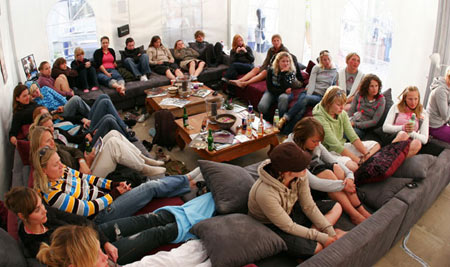As I have never been a girl to enjoy humiliation, instead of queuing on my own at cable full of wannabe-pros and cute beach boys, just to make a complete idiot out of myself, I opted for safer option of the Oakley Women Wakeboard Camp. Here I would not only have female support and company for my first faceplants into the water, but also coaching from the best pros in the business.
This was Oakley’s second wakeboard camp and was located at a cable park near Hamburg, Germany. Nestled between the incredibly comfy chill-out lounge and the huge tipi tent we slept in, there was a sandy beach where we would have our professional wakeboard coaching. Oakley pro wakeboarders Eva Koch, Mari Sandner, Ginger Pfennings and Aurie Brabänder were on hand to put us through our paces.
I was pleased to see the participants were a mixed crowd, with ages ranging from keen teens to adventure-loving mums in their thirties. We were similarly varied in our wakeboarding skills: from those who had never set foot on water to girls itching to learn the most stylish and difficult wake tricks.
We had the cable park completely to ourselves for the whole morning, so our 10-strong group had plenty of opportunities to fine tune our skills and learn the tricks of the trade. I was thrilled to complete a whole round after only three trials! The coaches gave us heaps of support – holding up the nose of the board to help us get up, teaching us perfect timing to do a jump start and telling us what to do differently when we fell!
I’ve always found it really hard to figure out what’s going wrong by myself when I learn new sports, so having a coach like Mari, who studies sport science alongside career as professional wakeboarder, was great. She took the time to explain in detail what had caused a slam, and gave me some incredibly worthwhile advice. “I always tell beginners to make sure their knees are bent,” says Mari. “And I’m sure they have the feeling their knees are bent – but in fact they’re not and I won’t stop until they do it properly!”
When you’ve finally mastered the art of getting upright without plunging into the lake face-first, and have managed to ride a couple of rounds comfortably, you can start to do bunny hops (little ollies on the water) and try to ride switch to increase your security on and feeling for the board. Coaches Eva and Mari agree, that it is vital to have perfect control over your board before learning tricks: “There’s no use in trying to learn a 360 over the kicker if you can’t even do a 180 on the water,” says Mari.

If you feel ready to learn tricks, the box is the easiest to start with. Let the cable drag you over the obstacle to get a feeling for it and try not to use the edges of your board. If you’re more into flying, obviously you’ll rather head for the kicker. You can prepare spins by going over the kicker and slightly turning your board a bit and back, which will give you a feeling for the torsion. By far the most effective way to learn any new trick is the double rope (even the pros use it). Under supervision of the other coaches, Ginger joined one of the girls on her cable with a second rope so they were riding side by side. That didn’t only give the girl a chance to observe very closely how the trick is carried out before reproducing it, but Ginger could also observe her and analyse her riding.
If you don’t manage to stand up on the board, complete a full round or do a backroll right away, you need to keep on trying! “Be patient and try, try and try again and never let your courage slip away,” advises Ginger.
Even Mari, who has won several national and international titles in her career, wasn’t born with a wakeboard strapped to her feet. “It took me three days to stand up on the board and ride it for the first time. I didn’t have anyone to teach me then, so I had to find out by trial and error all by myself,” she says.
Although watching her gracefully flying through the air today, you wouldn’t believe that she fared as badly as me when she first tried the sport!
“People have different abilities to learn different courses of movements,” reassures Mari. “Sometimes a different motion sequence is easier for you to learn than another one”. Instead of giving up or becoming desperate, just try something else. If you can’t manage a dock start, try a jump start, if you have problems doing a 50/50, try boardslides instead.
So if you aren’t up for water-based humiliation but still want to learn a new sport or improve your existing skills, try an all-girls camp like the Oakley Women Camps. Instead of making half the lake laugh at you and having the hot wakeboarder dudes looking down on you pitifully, you’ll have a bunch of girls cheering for you if ride only two meters and very compassionate coaches, who will fish you out of the lake and encourage you even after the fortieth plunge! The atmosphere between the girls was great the whole weekend (not even a second of bitchiness!), and without the pressure of being compared or comparing themselves to boys all the time, all the attendees had some kind of feeling of achievement and success. We all left the camp with loads of memories of a weekend packed with fun, a great deal of new or improved skills and very, very sore muscles.
The Oakley Women Wakeboard Camp is coming back next year, but if you’re super-keen to try out a weekend of demanding sports in the supportive environment of an all-girls camp, check out the Oakley Women Mountainbike Camp in Livigno, Italy in August or the Oakley Women Beach Volleyball or Snowboard Camps later this year where more pros will be on hand to put you through your paces!
Words by Anna Langer
